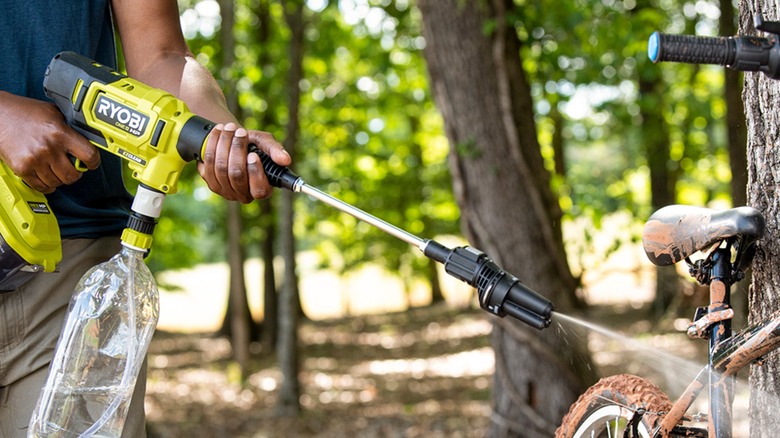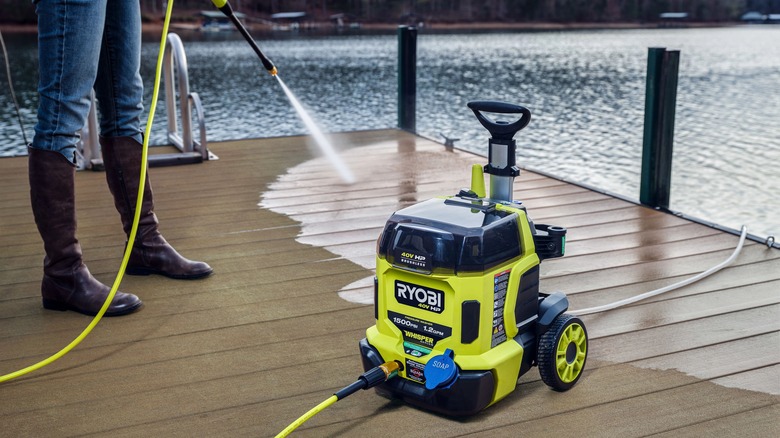Why Your Ryobi Pressure Washer Has Low Pressure (And How To Fix It)
Alongside its primary array of handheld tools and lawn care products, the Ryobi brand offers a variety of pressure washers too. These washers run the gamut of sizes, strengths, and intended purposes. For example, the company sells a compact, $149 handheld washer for a quick blast of water, and it also sells a $599 full washer cart intended for concentrated, powerful streams. No matter what kind of washer you're using, though, there's an obvious assumption that the device in question should be able to launch a strong pressurized jet of water. If it's not doing that, it kind of defeats the purpose.
If you're experiencing low, unworkable pressure in your Ryobi pressure washer, there are a handful of potential causes that could be affecting the device both inside and out. The good news is that, in all likelihood, the problem isn't the result of a serious mechanical failure. Most low-pressure scenarios can be determined and remedied with a critical eye and bit of elbow grease.
Problems outside of the washer
Before you assume something is wrong with the pressure washer itself, you should first take some time to diagnose its external elements. Unless you're using a model with a self-contained water tank, you'd have to draw water from a connected garden hose. Check the length of the hose for any kinks, blockages, or obvious obstructions and smooth it out. If you're drawing from a non-main water source, make sure there's enough pressure to reach a really good PSI level for the washer. If you're just sucking water out of a shallow bucket, there may not be enough pressure on the other end to actually draw water into the washer.
If the model you're using does have a tank, open it up and inspect the water inside. If the water is dirty, there may be debris clogging things up. Empty out the water bucket and then refill it with clean water.
While the handheld pressure washers from Ryobi are powered by the brand's ONE+ and 40V battery packs, the heftier ones may use a regular power cord. If you're using a corded power washer, make sure you're not using any more than one extension cord. Too many extension cords at once is dangerous and could dilute the flow of electricity to power the washer. You should also make sure the cord you're using is made for the outdoors, and Ryobi says it should ideally be no more than about 80 feet long.
Problems inside of the washer
If you're fairly sure that the cause of the washer's low pressure is within the washer itself, then there are a few quick checks and fixes you can perform. Make sure you start with these, avoid taking the washer apart unless you have professional-level experience with this sort of thing. If you take it apart without knowing how it works, you may not be able to fix it.
First, check the washer's line and tap setting. The line needs to be primed with running water for a couple of minutes to push out any loose air before the stream becomes consistent, while the tap setting should be set to medium pressure.
Next, check the surface of the spray nozzle. If you were using contaminated water or just left it out for a while, there may be debris clogging it up. Either swap the nozzle out for another or detach it and give openings a gentle prod to loosen any stuck gunk. Depending on the model of Ryobi pressure washer you purchased, it may come with a cleaning tool, but otherwise, any thin metal rod will do.
Finally, if you're using one of the larger pressure washers, it may be equipped with an inline water filter, which can get clogged. Remove the filter from the device to clear out any large obstructions and give it a wash with clean water before reinserting it.
If you still need help, visit Ryobi's support website.

